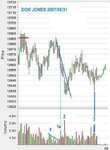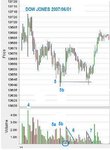bracke said:ljyoung
Many thanks for your reply especially after losing your first effort (its a pain when that happens).
My question was refering to the deliberate delay that a broker/mm is allowed before recording a trade. I thought that I had read that a delay of several hours was permitted between the trade and recording it for the market to see. If I am correct can the trade be shown on the next days volume.
What is T&S and B/A?
Regards
bracke
bracke,
T&S = Time and Sales; B/A = Bid/Ask
I believe you are quite correct that MM's can delay the reporting of a trade when "certain circumstances" apply (one of which is very large volume but there are probably others like the fabled 'lost ticket'"). The time frame for reporting differs from exchange to exchange and I'm pretty sure it is 90 seconds for the NASDAQ. The exchanges monitor this sort of thing and if a MM has a lot of these delayed events there can be consequences of some sort (a nasty tongue-lashing or worse, some sort of 'comfy chair' brutality).
However in Tom William's book it does state that his TradeGuider software can detect and ignore the late trades which I interpret to mean that because the MM has to report the late trade in sequence, then what the software will pick up is a jump in volume of a previously recorded trade and if said jump fulfils some sort of absolute or relative volume criterion, it is ignored.
What I said in my lost long version is that I had NOT gone back and assiduously checked all the volume bars for fidelity, but in day to day use had not noticed anything repetitively obvious with respect to changes in the magnitude of the volume bars (this in stark contrast to my observations when using IB, Prophet or Ameritrade as my data provider and employing the "refresh routine" as a way to try and get accurate data). I have checked price very closely though and find it exceedingly rare that there is a readjustment and when there has been one it is $0.01-0.02 for an equity like GOOG.
So it may well be that close scrutiny of volume bars will on occasion show a large change in magnitude but I don't think anything can be done about it. There may well be more than a bit of "nod and wink" activity going on between MM's when this sort of thing happens but the average small (or even large) retail trader isn't going to know about it and so in some sense that group of players will still be playing on the same field (the muddy, pothole-ridden quagmire).
We are left then to the not so tender mercies of ze exchange police who must keep some sort of limit on this type of thing but what that limit is and how rigorously it is enforced, I don't know. Again however we have the experience of other players and Mr. William's book to suggest that the MM's aren't doing this very frequently.
If there are any other questions please fire away and thank you for your interest.
Sincerely,
lj


